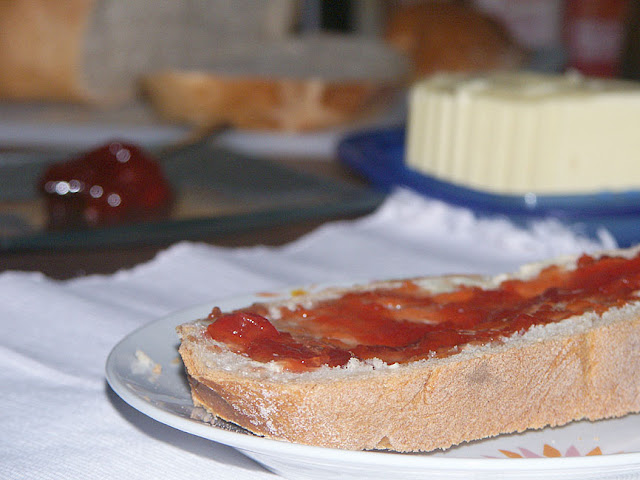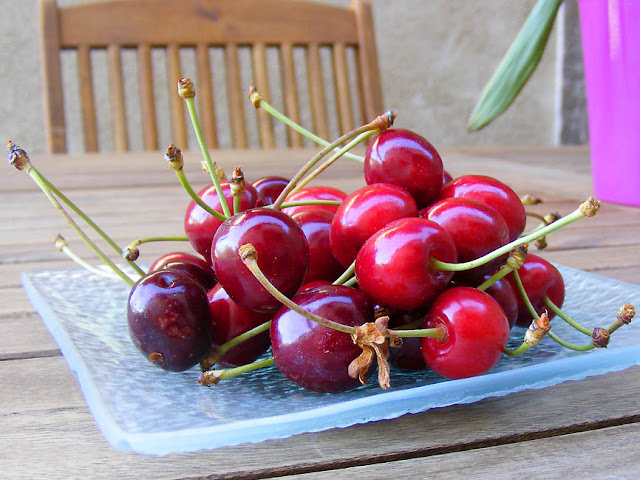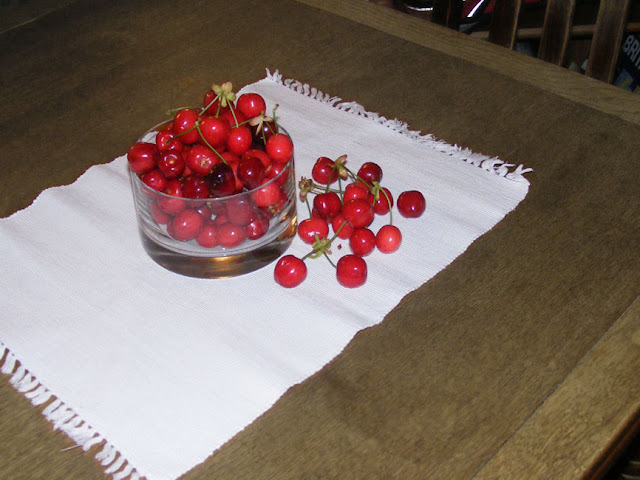Cherries are one of my favourite fruits, but I never lived anywhere
that they grew well until I moved to the Touraine Loire Valley. They
absolutely thrive here and many people have one in their garden. I
have eight in my orchard. They also grow wild in the forests, and are
a part of the indigenous mix of broadleaf decidous species in natural
woodland here.
 |
| Homemade cherry jam on a slice of boule for breakfast. |
There are two basic types of edible cherry in the Loire Valley –
sweet, known as bigarreaux; and sour, known as guignes.
They are two different species, with the sweet ones particularly
having various varieties and cultivars. A cherry tree is known as a
cerisier if it produces sweet fruit, a guignier if it
produces sour fruit, and a merisier if it is a
wild tree in the forest.
The cherry season is brief, May through June, but if it is a good
year I will be picking several kilos a day and having to think of
ways to process them. The two most common uses for cherries in a
Loire Valley kitchen will be the simple traditional dessert
clafoutis, or a cherry liqueur made by macerating cherries in sugar
and alcohol (this is super popular with my non-French friends and
family, and can be used to make a version of the popular aperitif
kir). I will also make coulis and confiture (jam), and a sweet spicy
sauce for use with meat. And then there is pie, sponge and crumble,
syrup, jelly and compote.
Burlat is the earliest widely known cherry variety in France and
opens the season of sweet eating cherries, signaling the return of
summer. It takes its name from Léonard Burlat, who grew the first
one from seed. Bright red, heart-shaped, it is sweet and juicy with a
texture not too squishy, not too firm.
Next to ripen are the sour cherries known as guignes here, but called griottes in many places. The name griotte comes from the Provençal word for bitter. Guignes very juicy and pleasantly acidic, sometimes with a touch of bitterness. They are rarely eaten fresh, but make excellent eau-de-vie, preserves and vinegar, and provide a sweet'n'sour foil to charcuterie(cured meat),magret de canard (fat duck breast) or fromage de chevre (goats cheese). My friend Christine tells me that in the old days when people made them into a liqueur they were set out in glass jars in the sun, but her granny always said the proper way to do it was to put them out in moonlight! Both Christine and I blithely disregard Granny and just leave our jars of cherries in sugar on a kitchen bench for about six weeks until the cherries have all shrivelled up and released all their juice and flavour into the sugar.
One of the most popular bigarreaux is a variety called Napoleon. Not often seen at the market, it is widely grown in people's gardens. It can be recognised by its big yellow heart-shaped fruits, spotted with scarlet. It is generally left alone by the birds, who don't realise it is ripe. Its juice is colourless and flesh firm, with a strong skin giving a satisfying mouthfeel when you bite into one.
There is a lot of confusion over cherry nomenclature and ancestory.
From my reading I have established that griottes, or Morello cherries, are small dark sour cherries, derived from wild Sour Cherry Prunus cerasus with dark flesh and red juice, so our guignes are not the same as griottes. However, true guignes are soft sweet cherries with coloured juice derived from wild Sweet Cherry P. avium, just as the firm sweet bigarreaux are. I think what we have in the Loire Valley are actually amarelles, which are sour cherries having pale red fruit and colourless juice, bred, like the griottes, from P. cerasus.
 |
| Homegrown sour cherries. |
The little guignes are thin skinned, fragile and sour, with translucent scarlet skins and yellowy flesh. They have a natural spiciness which gives jams and sauces a certain zing. The bigarreaux are large and sweet, with quite tough skin and firm flesh.
Wild Sour Cherry is a woodland tree, smaller than wild Sweet Cherry and a more reliable cropper that bears at a younger age and can be pruned harder. It is also self fertile, which means that seeds come true, unlike Sweet Cherry, which requires another nearby tree to cross pollinate with. Wild Sweet Cherries (merisiers) are one of the first forest trees to blossom, and as they are tall trees covered in lacy white flowers you can spot them from quite a distance.
 |
| Honey bee on cherry blossom in our orchard. |
 |
| Homegrown sweet cherries. |
We once had lunch with friends at a local Ferme Auberge (a farm with a restaurant where the menu must be made from 70% ingredients raised on the farm). We laughed when we saw the dessert – a simple bowl of fresh dark cherries. We told the patron that we had spent the last week picking 30 kg of cherries from our own orchard. He said that he had that quantity in the freezer alone, and that his grandfather had planted the trees. Then he went off and fetched an alternative dessert of generously sized crême brûlées in attractive hand made bowls. Naturally we ate both cherries and crême brûlée.
 |
| Cherry varieties from left: Giant, Napoleon, amarelle. Coins from left: Australian 50c, British 10p, 1 euro, US dime. |
We are also on Instagram, so check us out to see a regularly updated selection of our very best photos.






5 comments:
Very interesting and informative post on cherries. I was on the impression that clafoutis originated in Limousin, the country around Limoges.
Cherries, black, sweet ones, are also, by far, my favorite fruit. Too bad the seasom is so short!
Griottes make very good cerises à l'eau de vie!
Interesting. We will miss our cherries again this year!
Our cherry tree died last year, having been over baked in the heat waves of summer I think. I'll miss it - but then we would have missed the cherries anyway, stuck in the UK. Let's hope we get to France in time to get some of the plums.
Your easy cherry clafoutis recipe is my favourite, go-to, recipe for the dish, btw.
I meant to add that if you're passing, the gooseberries will be ready soon, so help yourself.
Post a Comment